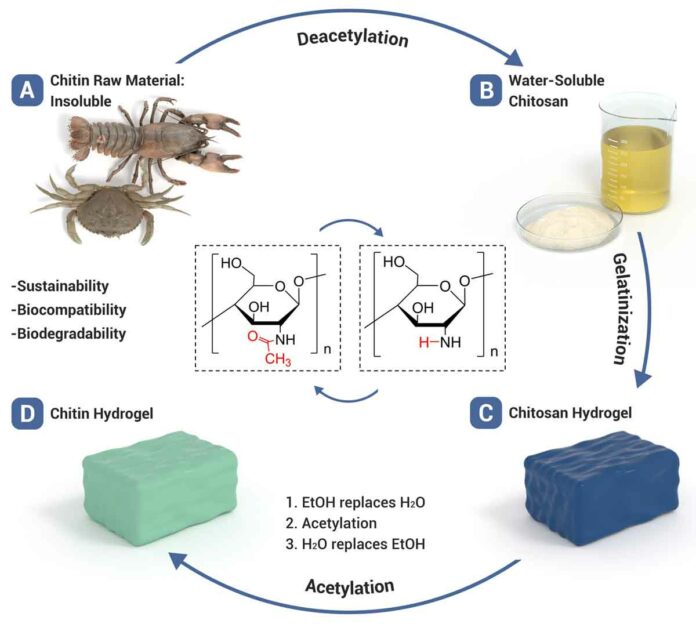In a groundbreaking development, scientists have achieved a major milestone in biomedical materials research with the successful fabrication of chitin hydrogel.
Chitin hydrogel, derived from the exoskeletons of crabs, prawns, and insects, has long been recognized for its potential in tissue repair, artificial organs, and wound healing.
However, its insolubility in aqueous solutions posed a significant challenge for scientists.
The team of researchers, led by Professor Li-Bo Mao from the University of Science and Technology of China, has now overcome this obstacle, ushering in a new era for the application of chitin hydrogel in the medical field.
The team’s remarkable achievement, recently published in the esteemed journal Nano Research, presents a sustainable and scalable approach for the preparation of chitin hydrogels, propelling its practical applications as a superior biomedical material.
A Natural Marvel: Chitin Hydrogel’s Biocompatibility and Potential
Chitin, the second most abundant natural polymer, is a renewable, biodegradable, and low-cost substance sourced from the exoskeletons of various marine creatures.
Its exceptional biocompatibility and mechanical properties make it a prime candidate for tissue engineering and regenerative medicine applications.
Breaking Barriers: Overcoming Insolubility and Ensuring Safety
The challenges in creating robust chitin hydrogel lied in its poor solubility in water and other common solvents, primarily due to strong inter- and intra-molecular hydrogen bonds in its polymer chains.
The researchers ingeniously tackled this issue by transforming chitosan, a water-soluble deacetylated derivative of chitin, into biomimetic chitin hydrogel structures.
Unparalleled Stability: The Acetylation Process
Through the process of acetylation, the team achieved chemically stable and antifouling chitin hydrogel.
This revolutionary chemical reaction conferred exceptional resistance to swelling, degradation, extreme temperatures, pH conditions, and organic solvents.
Biomimetic Marvels: Nacre-Like and Wood-Like Structures
The team’s ingenious approach allowed them to template the chitosan precursor with ice crystals, yielding chitin hydrogels with various biomimetic structures.
These structures can be either nacre-like or wood-like, depending on the freezing method used with the chitosan precursor.
Mechanical Supremacy and Unrivaled Antifouling Performance
The resulting chitin hydrogel exhibited outstanding mechanical properties while maintaining a high water content.
Furthermore, it demonstrated remarkable antifouling capabilities, resisting adhesion from proteins, bacteria, blood, and cells.
A Bright Future: Advancing Biomedical Applications
Professor Li-Bo Mao and his team are optimistic about the future possibilities for chitin hydrogel.
Their next step involves further enhancing the material’s mechanical properties and conducting in vivo experiments to explore its potential biomedical applications fully.
"We anticipate various chitin-based hydrogel materials can be fabricated through this strategy and used for different clinical applications, such as cartilage replacement, bone replacement, wound dressing, and even artificial organs," said Professor Mao.
Conclusion: Unleashing the Potential of Chitin Hydrogel
This groundbreaking research into chitin hydrogel presents a game-changing advancement in the field of biomedical materials.
The successful fabrication of this biomimetic marvel opens doors to a plethora of medical applications, promising improvements in tissue repair, organ replacements, and wound healing.
As further studies and experiments unfold, the true potential of chitin hydrogel may revolutionize the medical landscape, improving countless lives around the world.
FAQs
Chitin hydrogel is a material derived from chitin, the second most abundant natural polymer found in the exoskeletons of crabs, prawns, and insects. Its biocompatibility, biodegradability, and mechanical properties make it highly promising for various biomedical applications, including tissue repair, artificial organs, and wound healing.
The primary challenge in fabricating chitin hydrogel was its insolubility in water and common solvents due to the strong inter- and intra-molecular hydrogen bonds in its polymer chains. This made it difficult to produce hydrogel materials for biomedical use.
The research team tackled the solubility challenge by using chitosan, a water-soluble deacetylated derivative of chitin. Through a chemical transformation process called acetylation, they successfully obtained chitin hydrogel with outstanding chemical stability and resistance to various conditions.
By templating the chitosan precursor with ice crystals, the researchers were able to produce chitin hydrogels with different biomimetic structures. These structures can be either nacre-like or wood-like, offering versatile possibilities for biomedical applications.
The acetylation process the research team employed led to a chemically stable and antifouling chitin hydrogel. This exceptional characteristic allows it to resist swelling, degradation, extreme temperatures, pH conditions, and organic solvents.
Chitin hydrogel stands out for its natural origin, biocompatibility, and biodegradability, making it a superior choice for various biomedical uses. Its exceptional mechanical properties, combined with antifouling performance, set it apart from many other materials.
Chitin hydrogel holds tremendous promise in tissue engineering and regenerative medicine. It can be used in cartilage and bone replacements, wound dressings, and even artificial organs. Its versatile biomimetic structures make it a sought-after material for various clinical applications.
Yes, chitin hydrogel has demonstrated excellent biocompatibility and safety. Its resistance to biofouling reduces the risk of inflammatory responses or immune rejection, making it suitable for biomedical applications.
The research team aims to further enhance the mechanical properties of chitin hydrogels through ongoing studies. They also plan to conduct in vivo experiments to explore its full potential for various biomedical applications.
Chitin hydrogel’s remarkable properties, such as biocompatibility, mechanical strength, and antifouling capabilities, position it as a strong contender to replace or enhance conventional materials used in tissue engineering and regenerative medicine.
Chitin is a renewable and low-cost natural polymer, making chitin hydrogel a sustainable option for biomedical applications. Additionally, the team’s efficient and scalable preparation method further supports its potential for widespread use in the medical field.
More information: Nano Research (2023). DOI: 10.1007/s12274-023-5886-5

